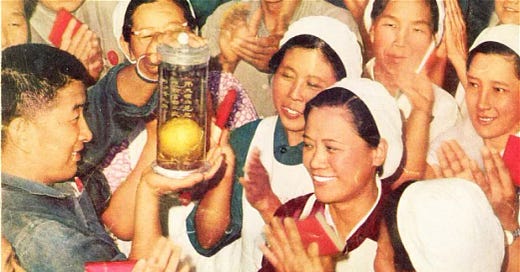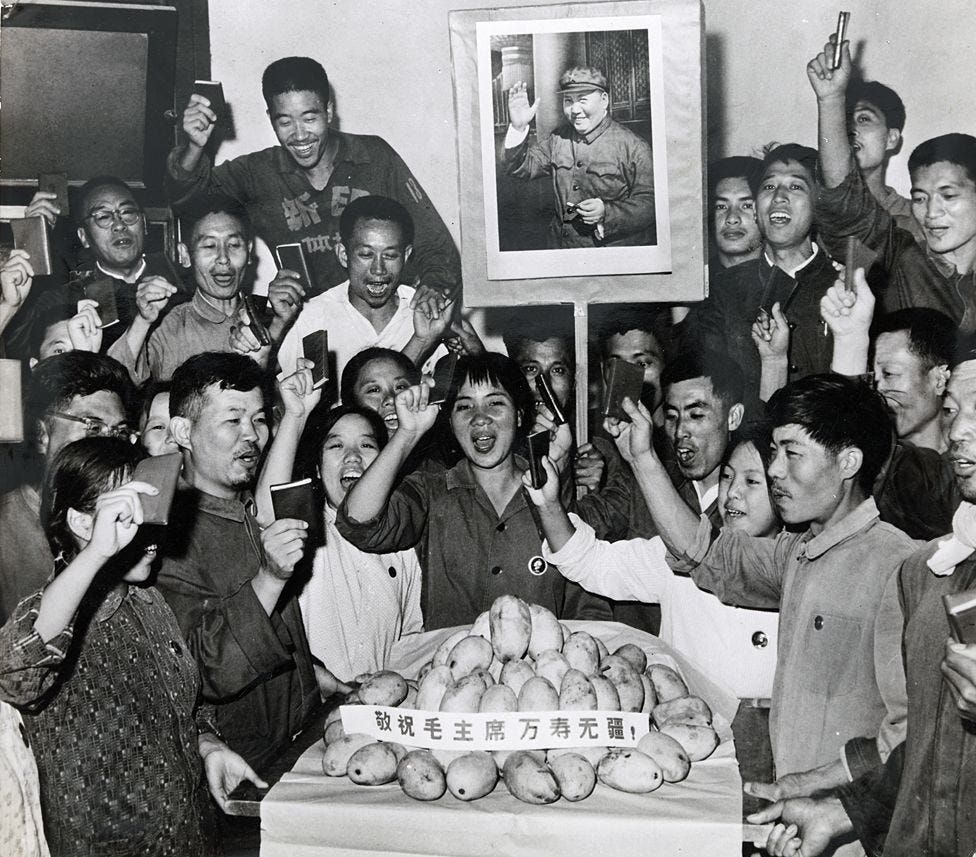The era of the Cultural Revolution Mango
How an unknown fruit came to embody the mass hysteria, personality cult, and political tactics that characterized that period in China.
Welcome back to this week’s Global Jigsaw. I am off with my family to Granada for the coming weekend, so am sending this post out a day early. It’s been a surprisingly cool week in Spain so far, but I believe the mercury will climb to 40 degrees by Sunday. Punishing, but I’m hoping the gardens of the Alhambra will be shady and fragrant nonetheless.
Talking of fragrance - nothing says hot weather quite like sweet, summer fruit.
A nation and its fruits
Every nation has its fruit. Japan has melons that sell at auctions for thousands of dollars. Indonesia has the malodorous durian that enthusiasts brave the stink of to sink their teeth into. Think China and a luscious peach, the classical symbol of longevity, comes to mind. In India, it’s the mango that is lusted after, its juicy sweetness relieving the harshness of the country’s summer.
In the years that I lived in Beijing, one of New Delhi’s policy priorities was to get approval for the export of Indian mangoes to China. The fruit had long been denied access to Chinese markets, in what was an oft quoted example of Beijing’s notorious non-tariff barriers.
It was while reporting on that story that I came across a fascinating chapter in the fruit’s Chinese history.
For there was a time in the 1960s when the mango in China was worshipped – quite literally – having taken on talismanic qualities that evoked mass hysteria. The mango in the China of the time was not to be eaten, but venerated, paraded, and beheld.
Red Guards vs Workers
How did this come to be? In the summer of 1966, the country was in chaos. Mao Zedong had unleashed the cultural revolution by calling on student Red Guards to rebel against “reactionary” authorities. Professors and administrators were beaten up and humiliated, as students took over university campuses.
Mao finally decided it was time to put an end to the anarchy, and as a way of reimposing order he sent groups of workers to university campuses to wrest back control from the Red Guards. In August of that year, 30,000 workers were sent to one of Beijing’s premier universities, Qinghua, armed with nothing but their copies of the Little Red Book of Mao’s quotations.
A (re) gift
The students attacked the workers with bricks, spears and sulfuric acid, killing five and injuring more than 700, before finally surrendering. Mao thanked the workers with a gift of approximately 40 mangoes, which he had been given the previous day by a visiting Pakistani minister.
And thus, the era of the Cultural Revolution Mango dawned, encapsulating the mass hysteria, personality cult, and political tactics that characterized that period in China.
The mango was a completely unknown fruit in northern China at the time. And given Mao’s God-like stature his gift of the mangoes evoked an overwhelming sense of wonder and gratitude in the workers.As a result, they stayed up all night looking at them, inhaling their scent and caressing them. They convinced themselves that Mao had blessed them with a magical fruit.
A BBC article article quotes Zhang Kui, one of the workers who was involved in the occupation of Qinghua, university as saying, "The military representative came into our factory with the mango raised in both hands. We discussed what to do with it: whether to split it among us and eat it or preserve it. We finally decided to preserve it."
"We found a hospital that put it in formaldehyde. We made it a specimen. That was the first decision. The second decision was to make wax mangoes - wax mangoes each with a glass cover. After we made the wax replicas, we gave one to each of the Revolutionary Workers."
The mango as relic
The mangos acquired a relic-like aura as workers began holding parades for wax models of the fruit, marching them up and down the streets of cities to the sound of beating drums. One of the “original” mangos was flow to a factory in Shanghai by chartered plane.
When the fruit began to rot they were boiled in water and workers lined up to sip a spoonful of the “holy” liquid, eucharist-style.
A poem from the period reflects the conflation between the person of Mao and the fruit:
Seeing that golden mango / Was as if seeing the Great Leader Chairman Mao!
Standing before that golden mango / Was just like standing beside Chairman Mao!
Again and again touching that golden mango: / the golden mango was so warm!
Again and again smelling the mango: / that golden mango was so fragrant!
Mao's gift was extolled as an act of selflessness, in which he’d sacrificed a precious possession for his love of the workers. In fact, the chairman apparently disliked the fruit and was greatly amused that an act of re-gifting a present he hadn’t particularly cared for, had created such a brouhaha.
The propaganda department of the Communist Party went into overdrive and quickly manufactured a smorgasbord of mango-themed items, from bed sheets to enamel trays and washbasins. Huge papier-mâché mangoes appeared on the central float during the National Day Parade in Beijing in October 1968.
The widespread enthusiasm that the fruit evoked was mixed in with relief at the thought that the chaos unleashed of the Cultural Revolution’s Red Guards had finally come to an end. The fruit became a symbol of the transition of power from the Red Guards to the working class.
The unfortunate dentist
But while some of the hoopla around the mango might have been inspired by genuine joy, there was also a coercive undercurrent to the whole episode. Attendance at the mango exhibitions, parades, and celebrations was often mandatory.
In a 2007 essay, historian Alfreda Murck recounts a fatal episode in Sichuan Province, where a village dentist was dragged through the streets and executed for disrespecting mangoes by comparing them to sweet potatoes.
China’s mango fever eventually fizzled out about a year and a half on, once the Red Guards had been brought firmly under control. The large number of wax replicas ended up being used as candles during power cuts.
On a visit to Beijing in 1974, Imelda Marcos took a case of the Philippine national fruit - mangoes - as a gift for her hosts, hoping to rekindle some mango magic. But to no avail. The mango’s moment in China had passed.
**************
If you enjoyed this story please do consider subscribing to the Global Jigsaw, so that I can keep writing these pieces. Your support is hugely appreciated and is necessary to keep this experiment in independent writing going.
And let me know your thoughts in the comments section.
Until next week.
Pallavi







Mangoes are called “Aam” in Hindi.That word “Aam” also means common in Hindi. Nice to hear about the aam having a khaas (special) time in China 🙂